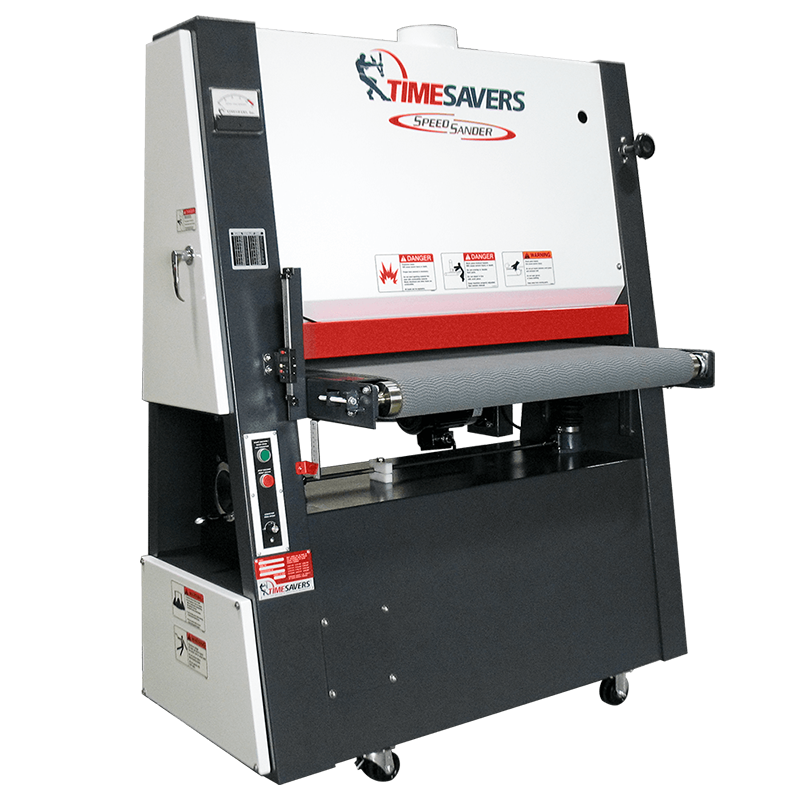Costa Sanders is a leading US supplier of industrial sanding and brushing machines for processing wood, metal, and other surfaces. Our modern and comprehensive product lines comprise highly successful machine families designed to satisfy today's needs for efficiency, performance, and durability. SCM Sandy win C5 63 25' wide belt sander Timesaver Ideal for the craftsman's workshop. The Sandya Win is an investment that allows you to progress from manual to automatic machining. It will improve the quality and potential of your work, as well as working environment this Machine is in excellent condition purchased in 2002 but has minimal use.
- Timesavers Sander Parts
- Timesaver 2300 Series Manual
- Timesaver Sander Manual
- Timesaver Sander Troubleshooting
Surface marks running the full width of the work piece are usually referred to as chatter marks. There are three types of chatter marks produced in a wide belt sander. The first is what is referred to as “machine chatter”. This chatter mark is usually close in spacing (approximately 1/8’ – 1/4” apart). It is similar to what “moulder marks” look like. It is usually caused from something mechanical in the machine. The second is what is referred to as “abrasive belt chatter”. This chatter mark is usually 1/2” in spacing. Most likely this chatter mark is coming from your abrasive belt. The third is “feed chatter”. Feed chatter is not as common as machine chatter or abrasive belt chatter. This chatter mark is most likely coming from your feed drive system. Normal causes of these chatter marks are a few of the five Items listed below.
- Lack of sanding pressure.
- Vibration in machine.
- Uneven feed.
- Out-of-round or flat spot in contact roll.
- Abrasive belt splice.
- Feed hesitation and stock slippage.
Inadequate Sanding Pressure
If marks show up in spots, it is generally due to inadequate sanding pressure or unevenness of surface on product. What is happening is your abrasive belt seam is “slapping” the material being sanded causing it to create a “skip” mark on your material. You can try to close the machine opening to increase sanding pressure or adjust your sanding head accordingly to the correct stock removal capabilities if that abrasive belt. If marks run across the full width of your work piece and are evenly spaced over the full length of the material being sanded and you are achieving the correct stock removal capabilities of your abrasive belt, then you should inspect the abrasive belt seam. A quick test to see if the abrasive belt seam is causing the chatter mark is to take a lumber crayon (preferably a bright color) and smear the entire abrasive belt seam with the crayon. Sand the material and see if that crayon mark transfers to the material. This is most likely abrasive belt chatter. Keep in mind you will ALWAYS get abrasive belt chatter when sanding with a steel drum not matter what type of seam you are using on your abrasive belt. If the abrasive companies could produce a seamless abrasive belt, they would eliminate abrasive belt chatter all together.
Vibration
Vibration in machines generally results from out-of-balance idler or contact rolls, worn v-belts or out-of-balance motor pulley. . If this develops after use, check contact roll and idler roll bearings and motor bearings. Also check your drive belts for proper tension. If the contact drum or idler roll has been changed or contact roll dressed, check for balance and run out. Prior to installing new bearings, make sure your shafts are not undersized. A tight tolerance must be maintained, usually less than .001”. Be sure the bearings were properly installed and not “hammered” onto the shafts. Hammering on your bearings could cause the precision balls to “pit” or “nick”. Make sure the floor on which your machine is mounted is of a solid surface (concrete, ect.). Yes I have machines out there sitting on a wooden floor! Be sure to check to see your machine is level using a machinist level. Your machine should have solid four corner contact with the floor. One other area to look at is the abrasive belt tensioning or lift pin used to tension your abrasive belt. Inspect for air leaks, wear or excessive “play”. You can try to increase or decrease the abrasive belt tensioning pressure and observe if there is a difference in the chatter marks occurs. Check to make sure your wide belt sanding heads are locked down properly. If not, they will “bounce” while sanding your material. In some cases I have seen loose bolts as well.
Uneven Feed
Run your material at any feed speed and measure the distance between the marks. Then change your feed speed and run a second piece and again measure the marks. If the distance between the marks remains the same as before, then the problem may be in your feed drive system (with variable feed speed only).
Check to make sure there is not excessive backlash or wear if equipped with a coupling or gear reducer if you suspect the chatter is caused by the feed drive system. Also check for conveyor feed belt “jerking” action.
Out-of-Round or Flat Spot in Contact Roll
Contact drums/rolls should be checked for roundness if it has been dressed or changed. Measure to outside diameter of the contact drum/roll using a micrometer. Removal of the contact drum/roll may be necessary to achieve an accurate reading. A dial indicator could be used on smooth contact drums/rolls. While manually rotating contact roll, observe any high spots. If roll is out-of-round, I would recommend having the contact drum/roll ground/turned/balanced and replace the bearings at the same time. It is very critical to have a contact drum/roll that spins at a high RPM balanced dynamically and accurately. An unbalanced roll will create a vibration which leads to bearing failure as well as other critical component failure.
Abrasive Belt Splice
The splice of an abrasive belt can create marks/chatter. The abrasive belt splice should be as close to the same thickness as the abrasive belt on either side of the splice. An open area (void of abrasive grit) at the splice can also create marks/chatter. A suggestion is a splice that is butted together, yet has no glue squeeze out and is equal in thickness as to the main area of the abrasive belt. Check with your abrasive belt manufacturer for recommendations. Abrasive belt seams of today are far different than ones used in past years. Abrasive belt manufactures are able to hold tighter tolerances on the seams as well as offering a superior joint that minimizes if not eliminates abrasive belt chatter.
Feed Hesitiation
Feed hesitation generally shows up as a “dip” or “wavy” surface on the sanded material. Do not get it confused with a “chatter mark”. The causes can be readily identified by their length and location. A “dip” is sometimes caused by the increased dwell time the material has underneath the sanding head, due to hesitation.
- A long “dip” or a “snipe” near the lead edge is most likely insufficient pressure on the infeed holddown rolls or shoes if equiped.
- A long “dip” or a “snipe” near the trailing edge is insufficient pressure on outfeed holddown rolls or shoes if equiped.
- Sporadic “waviness” or “dips” may be caused by poor conveyor belt conditions. A glazed, hard, or saturated conveyor belt that has lost its grip can cause hesitation. Most conveyor belts may be dressed to restore their driving friction. This can be accomplished by slowly bringing a running 60-80 grit abrasive belt into light contact with the running conveyor belt provided your contact drum is level and in good condition. It would help to make sure the bed plates are not showing wear as well. Allow thebelt to cycle a few passes before adjusting for more removal. I usually paint a bright stripe across the conveyor belt. This allows me to see where the belt is cleaning up and how much more material I need to remove. Once the paint is gone from the top surface all the way across, my conveyor belt has been successfully dressed. Do not get to aggressive with this process as heat is being generated. You are only removing a few thousandths of an inch per cycle and want to remove as little as possible from the conveyor belt but still achieve a uniform flat surface and restoring the original belt grip. (Note: Improper alignment of infeed/outfeed holddown rolls and/or shoes can cause hesitation).
Timesavers Sander Parts

Fast manual deburring, edge rounding and finishing of metal
This versatile machine has two heads that can be fitted with various types of tooling. Tooling includes different types of pads and brushes for deburring, edge rounding, finishing, laser oxide removal and heavy slag removal. Also, mirror finish can be created if required. With the 180 degrees rotating shaft it’s quick and easy to switch between different consumables.

Timesaver 2300 Series Manual
What makes the 10 series unique?
Timesaver Sander Manual
More info? Get in touch.
Timesaver Sander Troubleshooting
Timesavers area sales managers are the application expert with a lot of experience. They know like no other how to help you find the best solution to your problem.



